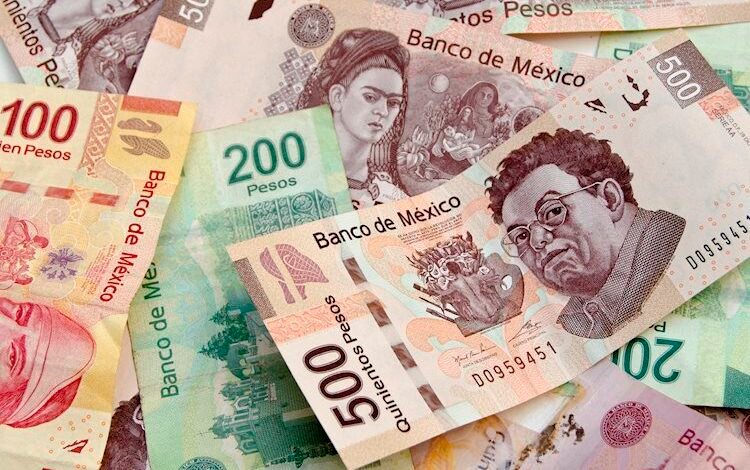Mexican Peso plunges on soft inflation, FOMC’s minutes

- Mexican Peso on the defensive as September inflation aims toward Banxico’s 3% goal.
- Banxico is expected to lower rates further after cutting to 10.50% in September, with additional easing projected by the end of 2024.
- The Fed’s September meeting minutes, sponsored a leg-up in the USD/MXN to 19.48.
The Mexican peso depreciated against the US Dollar on Wednesday following an inflation report that opened the door for further easing by the Bank of Mexico (Banxico). Meanwhile, the Federal Reserve (Fed) revealed its September Meeting Minutes. The USD/MXN trades at 19.48, up over 0.70%.
Mexico’s inflation edged lower in September, according to the Instituto Nacional de Estadistica Geografia e Informatica (INEGI). Headline and Core Consumer Price Index (CPI) readings came below estimates and trended toward hitting Banxico’s 3% plus or minus 1% goal.
The USD/MXN aimed higher as the data hints that Banxico could be more aggressive on its easing cycle. On Monday, Banxico Governor Victoria Rodriguez said the governing board may consider larger cuts to its benchmark rate as she spoke to Reuters.
Banxico lowered rates to 10.50% in September and is expected to ease at least an additional 50 basis points (bps) toward the end of 2024. The following meetings will be on November 14 and December 19.
The Fed’s September 17-18 Meeting Minutes in the US, showed that some officials would have preferred a 25-basis-point (bps) rate cut; all participants agreed on the need to lower interest rates. Regarding the Fed’s dual mandate, nearly all officials saw inflation risks tilted to the downside, whereas risks to the labor market were seen as tilted to the upside.
Following last Friday’s Nonfarm Payrolls (NFP) report, Fed officials adopted a more cautious stance. On Tuesday, Vice-Chairman Philip Jefferson said he remains data-dependent and that his approach will be meeting by meeting. Boston Fed President Susan Collins said further cuts are likely needed, but they would be data-driven.
In the meantime, the US Dollar Index (DXY), which tracks the buck’s performance against the other six currencies, climbs 0.37% to 102.85, underpinned by the jump in US Treasury yields.
Daily digest market movers: Mexican Peso tumbles following inflation report
- Last Thursday, Mexico’s Supreme Court voted eight to three to “consider a constitutional challenge to the controversial judicial overhaul enacted last month,” which would allow the election of judges and Supreme Court magistrates through electoral vote.
- Mexico’s CPI in September dipped from 4.99% to 4.58% YoY, exceeding estimates of 4.62%. Monthly inflation was 0.05%, below projections of 0.1%.
- Core CPI expanded by 3.91% YoY, below forecasts of 3.95%. Monthly core inflation was 0.28%, up from 0.22% but below estimates of 0.32%.
- According to Banxico’s poll, the central bank is projected to lower rates by 50 bps to 10% for the remainder of 2024. Meanwhile, the USD/MXN exchange rate will end at around 19.69.
- Mexico’s economy is projected to grow by 1.45% in 2024, lower than August’s 1.57%.
- Data from the Chicago Board of Trade (CBOT) via the December fed funds rate futures contract shows investors estimate 48 bps of easing by the Fed toward the end of 2024.
- Market participants have disregarded a 50 bps cut. The odds of a 25 bps cut are 81.4%, while the chances for holding rates unchanged are at 18.6%, according to the CME FedWatch Tool data.
USD/MXN technical outlook: Mexican Peso extends losses as USD/MXN jumps above 19.40
The USD/MXN regained the 50-day Simple Moving Average (SMA) at 19.37, which could open the door for further upside. Momentum favors buyers as depicted by the Relative Strength Index’s (RSI) bullish reading. Therefore, the exotic pair is headed to the upside.
If USD/MXN clears the psychological 19.50 level, look for buyers driving the exchange rate toward the October 1 daily high of 19.82, ahead of 20.00. Up next would be the YTD peak of 20.22.
For a bearish resumption, if USD/MXN drops below the October 4 wing low of 19.10, the 19.00 figure will be exposed. Once broken, the next support would be the 100-day SMA at 18.64.
Mexican Peso FAQs
The Mexican Peso (MXN) is the most traded currency among its Latin American peers. Its value is broadly determined by the performance of the Mexican economy, the country’s central bank’s policy, the amount of foreign investment in the country and even the levels of remittances sent by Mexicans who live abroad, particularly in the United States. Geopolitical trends can also move MXN: for example, the process of nearshoring – or the decision by some firms to relocate manufacturing capacity and supply chains closer to their home countries – is also seen as a catalyst for the Mexican currency as the country is considered a key manufacturing hub in the American continent. Another catalyst for MXN is Oil prices as Mexico is a key exporter of the commodity.
The main objective of Mexico’s central bank, also known as Banxico, is to maintain inflation at low and stable levels (at or close to its target of 3%, the midpoint in a tolerance band of between 2% and 4%). To this end, the bank sets an appropriate level of interest rates. When inflation is too high, Banxico will attempt to tame it by raising interest rates, making it more expensive for households and businesses to borrow money, thus cooling demand and the overall economy. Higher interest rates are generally positive for the Mexican Peso (MXN) as they lead to higher yields, making the country a more attractive place for investors. On the contrary, lower interest rates tend to weaken MXN.
Macroeconomic data releases are key to assess the state of the economy and can have an impact on the Mexican Peso (MXN) valuation. A strong Mexican economy, based on high economic growth, low unemployment and high confidence is good for MXN. Not only does it attract more foreign investment but it may encourage the Bank of Mexico (Banxico) to increase interest rates, particularly if this strength comes together with elevated inflation. However, if economic data is weak, MXN is likely to depreciate.
As an emerging-market currency, the Mexican Peso (MXN) tends to strive during risk-on periods, or when investors perceive that broader market risks are low and thus are eager to engage with investments that carry a higher risk. Conversely, MXN tends to weaken at times of market turbulence or economic uncertainty as investors tend to sell higher-risk assets and flee to the more-stable safe havens.
Information on these pages contains forward-looking statements that involve risks and uncertainties. Markets and instruments profiled on this page are for informational purposes only and should not in any way come across as a recommendation to buy or sell in these assets. You should do your own thorough research before making any investment decisions. FXStreet does not in any way guarantee that this information is free from mistakes, errors, or material misstatements. It also does not guarantee that this information is of a timely nature. Investing in Open Markets involves a great deal of risk, including the loss of all or a portion of your investment, as well as emotional distress. All risks, losses and costs associated with investing, including total loss of principal, are your responsibility. The views and opinions expressed in this article are those of the authors and do not necessarily reflect the official policy or position of FXStreet nor its advertisers. The author will not be held responsible for information that is found at the end of links posted on this page.
If not otherwise explicitly mentioned in the body of the article, at the time of writing, the author has no position in any stock mentioned in this article and no business relationship with any company mentioned. The author has not received compensation for writing this article, other than from FXStreet.
FXStreet and the author do not provide personalized recommendations. The author makes no representations as to the accuracy, completeness, or suitability of this information. FXStreet and the author will not be liable for any errors, omissions or any losses, injuries or damages arising from this information and its display or use. Errors and omissions excepted.
The author and FXStreet are not registered investment advisors and nothing in this article is intended to be investment advice.





